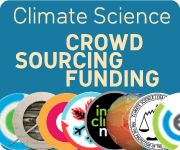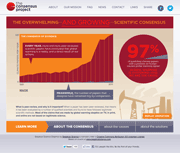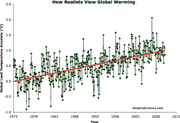Skeptical Science New Research for Week #9 2025
Posted on 27 February 2025 by Doug Bostrom, Marc Kodack
Open access notables
A twenty-first century structural change in Antarctica’s sea ice system, Raphael et al., Communications Earth & Environment:
From 1979 to 2016, total Antarctic sea ice extent experienced a positive trend with record winter maxima in 2012 and 2014. Record summer minima followed within the period 2017-2024, raising the possibility that the Antarctic sea ice system might be changing state. Here we use a Bayesian reconstruction of Antarctic sea ice extent which extends the record back to 1899, to show that the sequence of extreme minima in summer Antarctic sea ice extent is unlikely to have happened in the 20th century. We show that they represent a structural change in the sea ice system, manifest by increased persistence in the sea ice extent anomalies and a strongly reduced tendency to return to the mean state. Further, our analysis suggests that we may no longer rely on the past, long-term, behavior of the sea ice system to predict its future state. Extreme conditions may characterize the future state of Antarctic sea ice.
Recent Decline in Global Ocean Evaporation Due To Wind Stilling, Ma et al., Geophysical Research Letters
Ocean evaporation (Eo) is the major source of atmospheric water vapor and precipitation. While it is widely recognized that Eo may increase in a warming climate, recent studies have reported a diminished increase in the global water vapor since ∼2000s, raising doubts about recent changes in Eo. Using satellite observations, here we show that while global Eo strongly increased from 1988 to 2017, the upward trend reversed in the late 2000s. Since then, two-thirds of the ocean have experienced weakened evaporation, leading to a slight decreasing trend in global-averaged Eo during 2008–2017. This suggests that even with saturated surface, a warmer climate does not always result in increased evaporation. The reversal in Eo trend is primarily attributed to wind stilling, which is likely tied to the Northern Oscillation Index shifting from positive to negative phases. These findings offer crucial insights into diverse responses of global hydrological cycle to climate change.
Atlantification advances into the Amerasian Basin of the Arctic Ocean, Polyakov et al., Science Advances:
Atlantification—the northward inflow of anomalous waters and biota from the Atlantic into the polar basins—has wide-ranging climatological ramifications. We present previously unknown observational evidence that the atlantification processes are strengthening in the eastern Eurasian Basin. The primary example is the diminishing sea ice, which is related to a powerful ocean-heat/ice-albedo feedback, which accelerates sea-ice losses. Furthermore, we observe that atlantification is extending far beyond the Lomonosov Ridge into the Makarov Basin of the Arctic Ocean where upper ocean ventilation creates a new and unique ecological environment. The eastern part of the Siberian Arctic Ocean is still strongly stratified, but the atlantification-driven shoaling of warm, salty, and nutrient-rich intermediate waters already has important ecological consequences there. Disentangling the role of atlantification in multiple and complex high-latitude changes should be a priority in future modeling and observational efforts.
Record Early Sea Ice Loss in Southeastern Hudson Bay in Spring 2024, Soriot et al., Geophysical Research Letters:
Hudson Bay seasonal sea-ice cover plays an important role in marine ecosystems and human activities. Spring 2024 witnessed a uniquely early southeastern opening, leading to basin-wide sea ice extent falling 5 below the 1979–2023 average. Here, we show that a strong pressure gradient between high pressure over the Canadian Archipelago and low pressure to the south led to unusually strong and persistent winds from the east during May 2024. Consequently, the median sea ice opening date in the southeast was 31 days earlier than the 1979–2023 median, while sea ice opening in the west was delayed by 13 days. Early opening and warmer than average sea surface temperatures have extended the ice-free period to 202 days in southeastern Hudson Bay, with potentially dramatic consequences on the local marine ecosystem and contributed to the record low Arctic-wide sea ice extent by December 2024.
Against separation: the importance of transdisciplinary collaboration in climate action, Paiusco & Boem, Environmental Politics:
Addressing recent literature that supports the separation between climate science and climate activism, we stress the critical role that activists can play in disseminating scientific knowledge relevant to climate action. Furthermore, we encourage transdisciplinary collaboration and emphasize the importance of including climate ethicists and philosophers in the discussion.
From this week's government/NGO section:
Scaling up carbon dioxide removals. Recommendations for navigating opportunities and risks in the EU, Edenhofer et al., European Scientific Advisory Board on Climate Change
The authors outline key actions for the European Union (EU) to accelerate the deployment of carbon dioxide removals, emphasizing their potential to drive innovation, restore ecosystems, and create economic opportunities, while ensuring environmental and social safeguards. The authors offer nine recommendations to policy makers for rapidly scaling up removals, in ways that enhance EU’s industrial competitiveness while addressing associated opportunities and risks. These recommendations address both temporary removals, resulting from activities such as afforestation, reforestation, and soil carbon sequestration, and permanent removals, including technologies such as bioenergy with carbon capture and storage (BECCS) and direct air carbon capture and storage (DACCS).
Most Voters Have Heard Nothing About Carbon Removal, but Support Investing in It After Learning More, Catherine Fraser and Grace Adcox, Data for Progress
The authors surveyed 1,270 likely voters from January 24-27, 2025, to understand attitudes toward carbon dioxide removal (CDR), finding most voters still are largely unfamiliar with carbon removal. A majority of voters (63%) report having heard “nothing at all” about carbon removal, compared with 7% and 31% who report having heard “a lot” or “a little,” respectively. However, among voters who report hearing either a lot or a little about carbon removal, a bipartisan majority (56%) have a favorable opinion of it. Those who report having heard about carbon removal most often say they’ve heard about it from national broadcast television (32%) and social media (25%), relative to other sources.
160 articles in 58 journals by 957 contributing authors
Physical science of climate change, effects
Accelerated internal tides in a warming climate, Gong et al., Science Advances Open Access 10.1126/sciadv.adq4577
Anthropogenic intensification of Arctic anticyclonic circulation, Liu et al., Science Advances 10.1126/sciadv.ads4508
Changes in large-scale circulation behind the increase in extreme heat events in the Apennines (Italy), Capozzi et al., Atmospheric Research Open Access 10.1016/j.atmosres.2025.108013
Climate change alters the Indian Ocean Dipole and weakens its North Atlantic teleconnection, Fereday et al., Communications Earth & Environment Open Access 10.1038/s43247-025-02131-5
Continued Atlantic overturning circulation even under climate extremes, Baker et al., Nature Open Access 10.1038/s41586-024-08544-0
Recent Decline in Global Ocean Evaporation Due To Wind Stilling, Ma et al., Geophysical Research Letters Open Access 10.1029/2024gl114256
Observations of climate change, effects
A Decline in the Vertical Transport of Particulate Organic Carbon in the Global Open Ocean, Tian et al., Journal of Geophysical Research: Oceans 10.1029/2024jc021478
Atlantification advances into the Amerasian Basin of the Arctic Ocean, Polyakov et al., Science Advances Open Access 10.1126/sciadv.adq7580
Contrasting Trends in Colorado Fire Weather Index from Reanalysis and Observations, Silver & Lundquist, Journal of Applied Meteorology and Climatology 10.1175/jamc-d-24-0043.1
Impact of climate change on landslides along N-15 Highway, northern Pakistan, Ramzan et al., Advances in Climate Change Research Open Access 10.1016/j.accre.2025.02.004
Long-Term High-Resolution Radiosonde Measurements Reveal More Intensified and Frequent Turbulence at Cruising Altitude in China, Sun et al., Geophysical Research Letters Open Access 10.1029/2024gl114076
Observations of the Bottom Boundary Layer Beneath the World's Largest Internal Solitary Waves, Trowbridge et al., Open Access 10.22541/au.173016286.62781756/v1
Recent decades witness a strong east-west gradient of monsoon precipitation changes over Northern India, Kumari et al., Atmospheric Research 10.1016/j.atmosres.2025.108014
Reconstructed glacier area and volume changes in the European Alps since the Little Ice Age, Reinthaler & Paul Paul Paul, Open Access 10.5194/egusphere-2024-989
Record Early Sea Ice Loss in Southeastern Hudson Bay in Spring 2024, Soriot et al., Geophysical Research Letters Open Access 10.1029/2024gl112584
The Weakening and Poleward Migration of the Southeastern Front Associated With the South Indian Countercurrent From 1980 to 2023, Liang et al., Journal of Geophysical Research: Oceans 10.1029/2024jc021961
Instrumentation & observational methods of climate change, effects
A climate data record of atmospheric moisture and sea surface temperature from satellite observations, Fu et al., Open Access 10.5194/essd-2024-608
A global monthly 3D field of seawater pH over 3 decades: a machine learning approach, Zhong et al., Earth System Science Data Open Access 10.5194/essd-17-719-2025
System Vicarious Calibration for Climate and Global Long-Term Operational Ocean Color Applications, Zibordi et al., Bulletin of the American Meteorological Society 10.1175/bams-d-24-0085.1
Use of ICTs to confront climate change: analysis and perspectives, Escobar-Teran et al., Frontiers in Climate Open Access 10.3389/fclim.2025.1436616
Modeling, simulation & projection of climate change, effects
Climate-driven shifts in Southern Ocean primary producers and biogeochemistry in CMIP6 models, Fisher et al., Biogeosciences Open Access 10.5194/bg-22-975-2025
Constraining Future Antarctic Warming Under Five Different Emissions Scenarios in the CMIP6 Multi-Models, Sun et al., Geophysical Research Letters Open Access 10.1029/2024gl112662
Limited influence of the Agulhas leakage on the Atlantic Meridional Overturning Circulation under present-day climate conditions, Zhang et al., Communications Earth & Environment Open Access 10.1038/s43247-025-02097-4
Non-invasive in vivo monitoring of PROTAC-mediated protein degradation using an environment-sensitive reporter, Li et al., Nature Communications Open Access 10.1038/s41467-025-57191-0
Persistent austral winter storm track weakening beyond doubling of CO2 concentrations, Chemke, Nature Communications Open Access 10.1038/s41467-025-57285-9
Quantifying Climate Change-Driven Variations in Projected Wind Condition in the Gulf of Guinea, Dahunsi et al., Dynamics of Atmospheres and Oceans 10.1016/j.dynatmoce.2025.101543
Advancement of climate & climate effects modeling, simulation & projection
An improved and extended parameterization of the CO2 15 µm cooling in the middle and upper atmosphere (CO2&cool&fort-1.0), López-Puertas et al., Geoscientific Model Development Open Access 10.5194/gmd-17-4401-2024
Artificial intelligence for modeling and understanding extreme weather and climate events, Camps-Valls et al., Nature Communications Open Access 10.1038/s41467-025-56573-8
Can CMIP6 Models Accurately Reproduce Terrestrial Evapotranspiration Across China?, Shen et al., International Journal of Climatology 10.1002/joc.8794
Challenges in Unifying Physically Based and Machine Learning Simulations Through Differentiable Modeling: A Land Surface Case Study, Ahmad et al., Geophysical Research Letters Open Access 10.1029/2024gl112893
Statistical downscaling differences strongly alter projected climate damages, Miller et al., Communications Earth & Environment Open Access 10.1038/s43247-025-02134-2
Cryosphere & climate change
A minimal machine-learning glacier mass balance model, van der Meer et al., The Cryosphere Open Access 10.5194/tc-19-805-2025
A twenty-first century structural change in Antarctica’s sea ice system, Raphael et al., Communications Earth & Environment Open Access 10.1038/s43247-025-02107-5
East Antarctic tectonic basin structure and its implications for ice-sheet modeling and sea-level projections, Hansen & Emry, Communications Earth & Environment Open Access 10.1038/s43247-025-02140-4
Future Snow Scenarios for Northern Europe Based on Coupled Model Intercomparison Project Phase 6 Data, Räisänen et al., International Journal of Climatology 10.1002/joc.8795
Sea level & climate change
Coastal land subsidence accelerates timelines for future flood exposure in Hawai'i, Murray et al., Communications Earth & Environment Open Access 10.1038/s43247-025-02108-4
Large-scale loss of Mediterranean coastal marshes under rising sea levels by 2100, Schuerch et al., Communications Earth & Environment Open Access 10.1038/s43247-025-02099-2
Paleoclimate & paleogeochemistry
Cold spells over Greenland during the mid-Pliocene Warm Period, Sousa et al., Nature Communications Open Access 10.1038/s41467-025-56996-3
Paleorecords Reveal Biological Mechanisms Crucial for Reliable Species Range Shift Projections Amid Rapid Climate Change, Van der Meersch et al., Ecology Letters Open Access 10.1111/ele.70080
Shifts in Greenland interannual climate variability lead Dansgaard–Oeschger abrupt warming by hundreds of years, Brashear et al., Climate of the Past Open Access 10.5194/cp-21-529-2025
Warming-induced retreat of West Antarctic glaciers weakened carbon sequestration ability but increased mercury enrichment, Zhou et al., Nature Communications Open Access 10.1038/s41467-025-57085-1
Biology & climate change, related geochemistry
Arctic and Subarctic marine heatwaves and their ecological impacts, Pecuchet et al., Frontiers in Environmental Science Open Access 10.3389/fenvs.2025.1473890
Assessing the climate benefits of afforestation in the Canadian Northern Boreal and Southern Arctic, Dsouza et al., Nature Communications Open Access 10.1038/s41467-025-56699-9
Changes in biogeographic patterns of coastal fishes: Indicators of tropicalization in the Canary Islands over the last 40 years, González et al., Marine Environmental Research 10.1016/j.marenvres.2025.107002
Contrasting effects of temperature rise in different seasons on larger and smaller phytoplankton assemblages in a temperate coastal water, Laoshan Bay, northern Yellow Sea, China, Zhao et al., Marine Environmental Research 10.1016/j.marenvres.2025.107034
Differential Flight Responses of Sympatric Raptor Species to Weather Conditions and Extreme Temperature Events, Naves?Alegre et al., Ecology and Evolution Open Access 10.1002/ece3.70658
Host Species–Microbiome Interactions Contribute to Sphagnum Moss Growth Acclimation to Warming, Živkovi? et al., Global Change Biology Open Access 10.1111/gcb.70066
Impact of Carbon and Nitrogen Assimilation in Sargassum fusiforme (Harvey) Setchell due to Marine Heatwave Under Global Warming, Sheng et al., Global Change Biology 10.1111/gcb.70074
Metabolomic and phenotypic effects of ocean acidification on cuttlefish differ across early life stages., MINET et al., Marine Environmental Research Open Access 10.1016/j.marenvres.2025.107013
Potential Spatial Mismatches Between Marine Predators and Their Prey in the Southern Hemisphere in Response to Climate Change, Bas et al., Global Change Biology 10.1111/gcb.70080
Rising temperature increases the response time of LAI and GPP to meteorological drought in China, Wang et al., Atmospheric Research 10.1016/j.atmosres.2025.107989
Spatial and temporal variations in coral reef recovery amid recurring bleaching events in Okinawa Island, Japan, Afzal et al., Marine Environmental Research 10.1016/j.marenvres.2025.107033
Temporal trends in estuarine-resident fishes: Functional traits and responses to environmental and climatic variability, Escamade et al., Marine Environmental Research 10.1016/j.marenvres.2025.107019
The relative influence of climate extremes and species richness on the temporal variability of bird communities, Cady et al., Ecology 10.1002/ecy.70005
Tree Diversity Increases Carbon Stocks and Fluxes Above—But Not Belowground in a Tropical Forest Experiment, Schnabel et al., Open Access pdf 10.1101/2024.06.20.599915
Untangling the Complexity of Climate Change Effects on Plant Reproductive Traits and Pollinators: A Systematic Global Synthesis, Martén?Rodríguez et al., Global Change Biology Open Access 10.1111/gcb.70081
Using a bioindicator species to evaluate soil limitations for the recruitment of a recalcitrant tree seed species of Central Chile threatened by climate change, Morales et al., Frontiers in Forests and Global Change Open Access 10.3389/ffgc.2025.1394664
Vertical structure of subsurface marine heatwaves in a shallow nearshore upwelling system, Plume et al., Scientific Reports Open Access 10.1038/s41598-025-90565-4
Warming During Different Life Stages has Distinct Impacts on Host Resistance Ecology and Evolution, Li et al., Ecology Letters Open Access 10.1111/ele.70087
GHG sources & sinks, flux, related geochemistry
Asymmetrical Ocean Carbon Responses in the Tropical Pacific Ocean to La Niña and El Niño, Sun et al., Geophysical Research Letters Open Access 10.1029/2024gl112039
Continual migration of patches within a Massachusetts seagrass meadow limits carbon accretion and storage, Schaefer et al., Communications Earth & Environment Open Access 10.1038/s43247-025-02049-y
Coupling process of carbon sink service flow based on metacoupling framework, Zhang et al., Scientific Reports Open Access 10.1038/s41598-025-90606-y
Estimating GHG emissions from cloud computing: sources of inaccuracy, opportunities and challenges in location-based and use-based approaches, Soares et al., Climate Policy 10.1080/14693062.2025.2450054
Global consumption-based deforestation carbon emissions and regional hotspots: 2001–2015, Tang et al., Open Access 10.5194/essd-2024-619
Global warming may turn ice-free areas of Maritime and Peninsular Antarctica into potential soil organic carbon sinks, de Mello et al., Communications Earth & Environment Open Access 10.1038/s43247-024-01937-z
Invasive shrub (Lantana camara L.) alters the tree diversity and ecosystem-level carbon pools in tropical forests of Central India, Lone et al., Frontiers in Forests and Global Change Open Access 10.3389/ffgc.2025.1412130
Overstory and understory leaves warm faster than air in evergreen needleleaf forests, Ganz et al., Agricultural and Forest Meteorology 10.1016/j.agrformet.2025.110456
Responses of methane emissions to global wetland restoration and influencing factors, Xu et al., Agricultural and Forest Meteorology 10.1016/j.agrformet.2025.110459
Spatial and temporal variations of gross primary production simulated by land surface model BCC&AVIM2.0, Li et al., Advances in Climate Change Research Open Access 10.1016/j.accre.2023.02.001
Thermokarst lake drainage halves the temperature sensitivity of CH4 release on the Qinghai-Tibet Plateau, Mu et al., Nature Communications Open Access 10.1038/s41467-025-57356-x
Unprotected carbon dominates decadal soil carbon increase, Liu et al., Nature Communications Open Access 10.1038/s41467-025-57354-z
Whole-Profile Soil Carbon Responses to Concurrent Warming and Precipitation Changes Across Global Biomes, Wang et al., Global Change Biology 10.1111/gcb.70105
CO2 capture, sequestration science & engineering
Economic feasibility of biochar for carbon stock enhancement in Finnish agricultural soils, Jokub? et al., Carbon Management Open Access 10.1080/17583004.2025.2465328
Decarbonization
Abandoning renewable energy projects in Europe and South America: An emerging consideration in the recycling of energy landscapes, Frolova et al., Energy for Sustainable Development Open Access 10.1016/j.esd.2025.101676
Environmental and social impacts of self-financed solar PV adoption in rural Zambia: Insights from mopane worms, mushrooms, fishing, bushmeat and ethnomedicine, Chanda et al., Energy for Sustainable Development Open Access 10.1016/j.esd.2025.101665
Lithium dreams, local struggles: Navigating the geopolitics and socio-ecological costs of a low-carbon future, Chaudary, Energy Research & Social Science Open Access 10.1016/j.erss.2025.103952
Sustainable photovoltaic recycling to mitigate environmental pollution under climate and resource constraints, Guo et al., Journal of Industrial Ecology 10.1111/jiec.13599
The Environmental Emission and Climate Change Impact of Hydrogen Fuel Derived from Photocatalysis Water-Splitting Reaction, Nelson et al., Advanced Energy and Sustainability Research Open Access 10.1002/aesr.202400337
Uncovering the applications, developments, and future research directions of the open-source energy modelling system (OSeMOSYS): A systematic literature review, Plazas-Niño et al., Energy for Sustainable Development Open Access 10.1016/j.esd.2024.101629
Aerosols
A global dust emission dataset for estimating dust radiative forcings in climate models, Leung et al., Atmospheric Chemistry and Physics Open Access 10.5194/acp-25-2311-2025
Aerosol Decline Accelerates the Increasing Extreme Precipitation in China, Zou et al., Geophysical Research Letters Open Access 10.1029/2024gl113887
Aerosol–Climate Interaction in the South Asian Region: A Focused Exploration of the Impacts of Ozone, Black Carbon, Optical Properties and Radiative Forcing in a Region of Significant Climate Change Dynamics, Uddin et al., International Journal of Climatology 10.1002/joc.8800
Contrasting the roles of regional anthropogenic aerosols from the western and eastern hemispheres in driving the 1980–2020 Pacific multi-decadal variations, Diao et al., Atmospheric Chemistry and Physics Open Access 10.5194/acp-25-2167-2025
Observations of high-time-resolution and size-resolved aerosol chemical composition and microphysics in the central Arctic: implications for climate-relevant particle properties, Heutte et al., Atmospheric Chemistry and Physics Open Access 10.5194/acp-25-2207-2025
Climate change communications & cognition
A Timely Study of Far-Right Climate Communication, Vowles, Environmental Communication 10.1080/17524032.2025.2465682
Climate change from B to Z: a cross-generational perception study in Spain, Divasson-J et al., Frontiers in Environmental Science Open Access 10.3389/fenvs.2025.1511398
Climate change risk perception as a catalyst for adaptive effect of ICT: The case in rural Eastern China, Yang et al., Climate Risk Management Open Access 10.1016/j.crm.2025.100697
Event triggers and opinion leaders shape climate change discourse on Weibo, Yang et al., Communications Earth & Environment Open Access 10.1038/s43247-025-02124-4
Ideological underpinnings of climate change beliefs: A 13-year longitudinal study, Milfont et al., Journal of Environmental Psychology Open Access 10.1016/j.jenvp.2025.102554
Information Processing and Response Among Global Warming’s Six Americas, Roser-Renouf et al., Environmental Communication 10.1080/17524032.2025.2464165
Latino Intergenerational Communication and Attitudes Regarding Climate Change, Vazquez & Adams, Environmental Communication 10.1080/17524032.2025.2464154
Personal damage from tropical disasters increases Republicans’ support for climate change policies, Del Ponte et al., Journal of Environmental Psychology 10.1016/j.jenvp.2025.102552
Plan(T)ing for the future: using socially engaged climate art to mobilize change agents, Roberti et al., Climate and Development 10.1080/17565529.2025.2468503
Agronomy, animal husbundry, food production & climate change
(Mal)adaptive outcomes of farmers’ adaptation strategies to climate change: comparison of three regions from Turkey, Gören, Climate and Development 10.1080/17565529.2025.2466055
Climate resilient development pathways for farmer producer organizations in semi-arid India, Srinidhi et al., Climate and Development Open Access 10.1080/17565529.2025.2459063
Climate-driven shifts in suitable areas of Alternaria leaf blotch (Alternaria mali Roberts) on apples: Projections and uncertainty analysis in China, Chen et al., Agricultural and Forest Meteorology 10.1016/j.agrformet.2025.110464
CropSuite v1.0 – a comprehensive open-source crop suitability model considering climate variability for climate impact assessment, Zabel et al., Geoscientific Model Development Open Access 10.5194/gmd-18-1067-2025
Future suitability of sweet chestnut (Castanea sativa Mill.) is limited by susceptibility to drought, Weise et al., Dendrochronologia Open Access 10.1016/j.dendro.2025.126299
Gender, intersectionality and climate smart agriculture in South Asia: A review, Rao et al., PLOS Climate Open Access 10.1371/journal.pclm.0000482
Influence of Initial Soil Organic Carbon in Grassland on the Sensitivity of Carbon Changes to Climate After Grassland-to-Cropland Conversion, Dou et al., Earth's Future Open Access 10.1029/2024ef005249
Interpreting mammalian synonymous site conservation in light of the unwanted transcript hypothesis, Christmas et al., Nature Communications Open Access 10.1038/s41467-025-57179-w
Modeling biochar effects on soil organic carbon on croplands in a microbial decomposition model (MIMICS-BC&v1.0), Han et al., Geoscientific Model Development Open Access 10.5194/gmd-17-4871-2024
Optimizing spatial allocation schemes with a focus on carbon fixation services by the integration of GIS and a robust algorithmic approach, Guo & He, Frontiers in Forests and Global Change Open Access 10.3389/ffgc.2025.1470065
Hydrology, hydrometeorology & climate change
Analysis of Spatio-Temporal Characteristics of Drought in Serbia From 1961 to 2020 Using SPI and SPEI, Filipovi? et al., International Journal of Climatology Open Access 10.1002/joc.8803
Aridity on the Rise: Spatial and Temporal Shifts in Climate Aridity in Spain (1961–2020), Beguería et al., International Journal of Climatology Open Access 10.1002/joc.8775
Exploring the roles of recorded unprecedented rainfall-runoff characteristics and uplifted riverbeds in the catastrophic 2022 Pakistan megaflood, Ahmed BAZAI et al., Advances in Climate Change Research Open Access 10.1016/j.accre.2025.02.003
Increasingly Seasonal Jet Stream Raises Risk of Co-Occurring Flooding and Extreme Wind in Great Britain, Hillier et al., International Journal of Climatology Open Access 10.1002/joc.8763
Climate change economics
Carbon performance and corporate financial performance during crises: Evidence from the COVID-19 pandemic and the Global Financial Crisis, Läger et al., Journal of Industrial Ecology 10.1111/jiec.13603
Effects of carbon pricing on inflation, Moessner, Climate Policy Open Access pdf 10.1080/14693062.2025.2467961
Is a New Economic System Necessary to Address Climate Change?, Stuart et al., WIREs Climate Change 10.1002/wcc.70003
Quantifying climate finance needs in the nationally determined contributions of developing countries, Isah et al., Climate Policy Open Access 10.1080/14693062.2025.2460607
Climate change mitigation public policy research
An equity-based approach for addressing inequality in electric vehicle charging infrastructure: Leaving no one behind in transport electrification, Jha et al., Energy for Sustainable Development 10.1016/j.esd.2024.101643
Connecting power to people: Integrating community renewable energy and multi-level governance towards low-carbon energy transition in Nigeria, Kaze et al., Energy Research & Social Science Open Access 10.1016/j.erss.2025.103938
Demand-side policies can significantly reduce emissions from energy use in buildings and transport, van Heerden et al., Nature Energy 10.1038/s41560-025-01721-z
Facing a fossil free future through the past: The importance of history for understanding fossil fuel phaseouts, Slothuus, Energy Research & Social Science Open Access 10.1016/j.erss.2025.103971
Implementing the twin transitions: A critical perspective from the Spanish energy sector, García Casañas & Kovacic, Environmental Science & Policy Open Access 10.1016/j.envsci.2025.104012
Incorporating aridity in soil carbon stewardship frameworks, Cotrufo & Lavallee, Nature Climate Change 10.1038/s41558-025-02270-9
Multi-country evidence on societal factors to include in energy transition modelling, Fisch-Romito et al., Nature Energy Open Access 10.1038/s41560-025-01719-7
Pay-back time: Increasing electricity prices and decreasing costs make renewable energy competitive, Batz Liñeiro & Müsgens Müsgens, Energy Policy Open Access 10.1016/j.enpol.2025.114523
Projection of Electricity Generation Profiles and Carbon Emissions Towards 2050: A Malaysia Context, Fernandez et al., Energy for Sustainable Development Open Access 10.1016/j.esd.2025.101681
Quantifying the cost savings of global solar PV and onshore wind markets, Chen & Han, Energy Policy 10.1016/j.enpol.2025.114521
Rethinking energy transition: Approaches from social representations theory, Conde & Takano-Rojas, Energy Research & Social Science Open Access 10.1016/j.erss.2025.104001
Seeking common ground? Heterogeneous support for carbon pricing and climate policies across audience segments, Barrez, Energy Research & Social Science 10.1016/j.erss.2025.103993
Understanding local opposition to renewable energy projects in the nordic countries: A systematic literature review, Sanchez Nieminen & Laitinen, Energy Research & Social Science Open Access 10.1016/j.erss.2025.103995
Willingness and influencing factors of rural Tibetan households to undergo energy transition: Evidence from China, Yang et al., Energy for Sustainable Development 10.1016/j.esd.2024.101641
Climate change adaptation & adaptation public policy research
Adaptive capacity management in municipalities in the semiarid region of Brazil: Application of a composite index, dos Santos & Pessoa Pessoa, Climate Risk Management Open Access 10.1016/j.crm.2025.100696
Bridging different ways of knowing in climate change adaptation requires solution-oriented cross-cultural dialogue, Roos & van der Sluijs, Frontiers in Climate Open Access 10.3389/fclim.2025.1544029
Data-driven robust transmission expansion planning against rising temperatures, Kyle Skolfield et al., Environmental Research: Infrastructure and Sustainability Open Access 10.1088/2634-4505/adb5b3
Does knowledge co-production influence adaptive capacity?: A framework for evaluation, Witinok-Huber et al., Environmental Science & Policy Open Access 10.1016/j.envsci.2025.104008
Flexible Climate Adaptation Can Substantially Reduce Conservation Costs and Mitigate Risk, Cho et al., Conservation Letters Open Access 10.1111/conl.13084
Improving economic assessment and decision-making for managed retreat through CBA+: a targeted literature review, Cross et al., Frontiers in Climate Open Access 10.3389/fclim.2025.1481824
Integrating power, justice and reflexivity into transformative climate change adaptation, Taylor et al., Global Environmental Change Open Access 10.1016/j.gloenvcha.2025.102981
Spatial assessment of current and future migration in response to climate risks in Ghana and Nigeria, Schürmann et al., Frontiers in Climate Open Access 10.3389/fclim.2025.1516045
Vulnerability assessment of rural households to climate change using livelihood vulnerability framework approach in the trans-Himalayan region of Ladakh, India, Namgyal et al., Anthropocene 10.1016/j.ancene.2025.100467
Climate change impacts on human health
Evaluating public health co-benefits of New York state’s climate leadership and community protection act, Cooley et al., Climate Policy Open Access 10.1080/14693062.2025.2465765
Projections of population exposure to hot and dry events in the end of the 21st century on the Iberian Peninsula, Bento et al., Frontiers in Climate Open Access 10.3389/fclim.2025.1519880
Prolonged coccidioidomycosis transmission seasons in a warming California: a Markov state transition model of shifting disease dynamics, Camponuri et al., Journal of The Royal Society Interface 10.1098/rsif.2024.0821
Other
Acting on climate change-driven incommensurable loss, Puig, Climate and Development 10.1080/17565529.2025.2462588
Modeling the impact of urban climate transformations in low income housing located in critical climate: A case study, da Cunha et al., Energy for Sustainable Development Open Access 10.1016/j.esd.2025.101653
Spatial and temporal evolution of future atmospheric reactive nitrogen deposition in China under different climate change mitigation strategies, Ma et al., Atmospheric Chemistry and Physics Open Access 10.5194/acp-25-2147-2025
Study: Countries across the world use more land for golf courses than wind or solar energy, Ebbage, Engineering & Technology Open Access 10.1049/et.2020.1005
Informed opinion, nudges & major initiatives
Against separation: the importance of transdisciplinary collaboration in climate action, Paiusco & Boem, Environmental Politics Open Access 10.1080/09644016.2025.2466242
Climate change in the Himalayan region: susceptible impacts on environment and human settlements, Matta et al., Frontiers in Environmental Science Open Access 10.3389/fenvs.2025.1550843
Constraining the entire Earth system projections for more reliable climate change adaptation planning, Li et al., Science Advances 10.1126/sciadv.adr5346
Global Precipitation Experiment—A New World Climate Research Programme Lighthouse Activity, Zeng et al., Bulletin of the American Meteorological Society Open Access pdf 10.1175/bams-d-23-0242.1
Impact of scientific research on the international climate regime: the strategic niche of the emissions gap reports, Alcamo et al., Frontiers in Climate Open Access 10.3389/fclim.2025.1534267
Injecting solid particles into the stratosphere could mitigate global warming but currently entails great uncertainties, Vattioni et al., Communications Earth & Environment Open Access 10.1038/s43247-025-02038-1
Mass firings decimate U.S. science agencies, Travis et al., Science 10.1126/science.adw8625
Models like heroes? Making Integrated Assessment Models (IAMs) ready for deep decarbonization and a socio-economic transformation, Krawczyk & Braun, Energy Research & Social Science Open Access 10.1016/j.erss.2025.103959
Opinion: Why all emergent constraints are wrong but some are useful – a machine learning perspective, Nowack & Watson-Parris Watson-Parris, Atmospheric Chemistry and Physics Open Access 10.5194/acp-25-2365-2025
The role of cross- and interdisciplinary climate research centres, Herziger & Hurst, Nature Climate Change 10.1038/s41558-025-02249-6
Articles/Reports from Agencies and Non-Governmental Organizations Addressing Aspects of Climate Change
Financing meat, dairy and feed production, Gerard Rijk and Léa Pham Van, Profundo
Climate risk is financial risk. U.S. banks are increasingly under pressure from policymakers, investors, and civil society to minimize this risk by reducing the greenhouse gas (GHG) emissions attributable to the loans, underwriting, investments, and other financial services they provide. The authors evaluate the climate-related financial risks that Bank of America, Citigroup, and JP Morgan Chase face in financing companies active in meat, dairy and feed (MDF) production. The authors foudn that in the near term (to 2030), the 31 meat, dairy, and feed corporations reviewed for the report could face US$116B in losses, putting US $0.43B to US $1.12B of the banks’ loans and investments in the 31 corporations at risk.
Polluting Education. The Influence of Fossil Fuels on Children’s Education in Canada, Anne Keary and Jennifer Chesnut, e Canadian Association of Physicians for the Environment and For Our Kids
The authors explore the involvement of the oil and gas industry in schools and climate-related education in Canada. The authors research documents the history and extent of industry involvement and the effect this has on the messages conveyed—and not conveyed—in the educational programs the fossil fuel industry supports. One of the key findings is that fossil fuel companies have, through their involvement in education effectively obscured the industry’s role in driving climate change while also limiting public understanding of the urgent need to transition away from fossil fuels. The authors describe governmental and institutional policy levers that could be used to protect climate change education from the fossil fuel industry and puts forward steps that parents, teachers, and concerned citizens could take to effect these policy changes.
Progress Report on the implementation of the Joint Communication - "A New Outlook on the Climate and Security Nexus", High Representative of the Union for Foreign Affairs and Security Policy, European Commission
The authors provide an overview of the progress made across the four pillars of the Joint Communication and the steps undertaken to implement each of its twenty-eight actions.
Scaling up carbon dioxide removals. Recommendations for navigating opportunities and risks in the EU, Edenhofer et al., European Scientific Advisory Board on Climate Change
The authors outline key actions for the European Union (EU) to accelerate the deployment of carbon dioxide removals, emphasizing their potential to drive innovation, restore ecosystems, and create economic opportunities, while ensuring environmental and social safeguards. The authors offer nine recommendations to policy makers for rapidly scaling up removals, in ways that enhance EU’s industrial competitiveness while addressing associated opportunities and risks. These recommendations address both temporary removals, resulting from activities such as afforestation, reforestation, and soil carbon sequestration, and permanent removals, including technologies such as bioenergy with carbon capture and storage (BECCS) and direct air carbon capture and storage (DACCS).
Navigating Peace in a Changing Climate. Climate and Security Trend Analysis, Whitaker et al., adelphi Global
The authors used a mixed methods approach that offers a clear advantage in studying climate and security interactions across different time scales, avoiding overreliance on models trained on historical data. The analysis centers on five core pathways on which policymakers need to focus to accurately assess climate risks in the coming years. These core pathways are analyzed with a comprehensive range of risk determinants including vulnerability and resilience. The five pathways are water governance, food pricing, and natural resource management; migration, displacement, and livelihoods; energy transition, decarbonization risks, and critical minerals; environmental degradation, biodiversity loss, and environmental crime; and global governance, financial reform, and climate justice
Assessing the impact of a nuclear pathway on Australia’s emissions, Climate Change Authority
Australia’s current policy direction aims to modernize electricity generation through renewables, storage, and firming. The authors explore how the adoption of an alternative pathway with nuclear could impact national emissions reduction targets and commitments to 2050. Compared with the current national pathway which is set to see coal-fired generators fully replaced by a mix of renewables and firming by 2040, the analysis finds the alternative pathway would mean an additional 1 billion tonnes of emissions from the electricity sector, and likely at least that amount again economy-wide by 2050; pursuing a pace of climate action that is consistent with a global pathway to around 2.6°C of warming, a level at which scientists, economists and governments anticipate major social, economic and environmental harm; and, missing Australia’s legislated 43% national emissions reduction target for 2030 by more than five percentage points, and still not achieving this level of reduction by 2035.
The Global Campaign Against Building Electrification, InfluenceMap
The authors show how the oil & gas and utilities industries are leveraging a common fossil fuel playbook to prolong the use of fossil gas in buildings globally. The analysis includes three case studies from Australia, the European Union, and the United States to demonstrate how these industries are deploying specific narratives to block or weaken building electrification policies in these regions. The findings indicate that this strategic and coordinated campaign is risking public health and climate goals by delaying building electrification policy.
State of the Sector: Critical energy transition minerals for India, Chadha et al., International Institute for Sustainable Development
As the world shifts toward sustainable development, securing a reliable supply of critical energy transition materials (CETMs) has never been more vital and essential for renewable energy technologies. Like most progressive nations, India has embarked on several low-carbon technology initiatives and has committed to achieving net-zero emissions by 2070, which necessitates a responsible and reliable value chain of CETMs.
Navigating risks to unlock 500 GW of renewables by 2030, Neshwin Rodrigues and Duttatreya Das, Ember
India requires unprecedented investment in renewables, storage, and grids to achieve its target of 500 GW of clean power by the end of the decade. Facilitating this large-scale infrastructure build-out demands low-cost capital, which hinges on effectively managing risks. The authors examine investment risks in India’s renewable energy sector and outline strategies to address them.
Oxford Climate Policy Monitor. 2024 Annual Review, Lecavalier et al, University of Oxford
Creating ambitious, effective, and comprehensive rules for a net zero-aligned economy is an unprecedented, whole-of-government challenge. Policy and regulatory responses are multi-level, multi-domain, multi-jurisdiction, and highly technical. The Oxford Climate Policy Monitor is a new data resource launched in 2024 with the intent of supporting governments, the private sector, civil society, and researchers to better climate policy. Through pro bono research partnerships with leading law firms worldwide, the Monitor maps and evaluates climate regulation, law, and policy to reveal how government rules are aligning—or not—with global climate goals.
Sustainable Energy in America. 2025 Energy Factbook, Bloomberg NEF and The Business Council for Sustainable Energy
The Factbook aims to augment existing public sources of information on U.S. energy. The report focuses on renewables, efficiency, natural gas, distributed power and storage, and sustainable transportation. It also fills important data gaps in certain areas, such as clean energy investment flows and distributed energy. Energy growth has returned to the US power system. Between 2009 and 2024, the compound annual growth rate for electricity sales in the country was 0.6%, or roughly flat. This changed in 2024, with rapidly rising expectations of power demand from new industrial sources and transportation, on-shoring of US manufacturing, and a burst of new data centers planned by tech companies in the race for artificial intelligence mastery.
Most Voters Have Heard Nothing About Carbon Removal, but Support Investing in It After Learning More, Catherine Fraser and Grace Adcox, Data for Progress
The authors surveyed 1,270 likely voters from January 24-27, 2025, to understand attitudes toward carbon dioxide removal (CDR), finding most voters still are largely unfamiliar with carbon removal. A majority of voters (63%) report having heard “nothing at all” about carbon removal, compared with 7% and 31% who report having heard “a lot” or “a little,” respectively. However, among voters who report hearing either a lot or a little about carbon removal, a bipartisan majority (56%) have a favorable opinion of it. Those who report having heard about carbon removal most often say they’ve heard about it from national broadcast television (32%) and social media (25%), relative to other sources.
Obtaining articles without journal subscriptions
We know it's frustrating that many articles we cite here are not free to read. One-off paid access fees are generally astronomically priced, suitable for such as "On a Heuristic Point of View Concerning the Production and Transformation of Light" but not as a gamble on unknowns. With a median world income of US$ 9,373, for most of us US$ 42 is significant money to wager on an article's relevance and importance.
- Here's an excellent collection of tips and techniques for obtaining articles, legally.
- Unpaywall offers a browser extension for Chrome and Firefox that automatically indicates when an article is freely accessible and provides immediate access without further trouble. Unpaywall is also unscammy, works well, is itself offered free to use. The organizers (a legitimate nonprofit) report about a 50% success rate
- The weekly New Research catch is checked against the Unpaywall database with accessible items being flagged. Especially for just-published articles this mechansim may fail. If you're interested in an article title and it is not listed here as "open access," be sure to check the link anyway.
How is New Research assembled?
Most articles appearing here are found via RSS feeds from journal publishers, filtered by search terms to produce raw output for assessment of relevance.
Relevant articles are then queried against the Unpaywall database, to identify open access articles and expose useful metadata for articles appearing in the database.
The objective of New Research isn't to cast a tinge on scientific results, to color readers' impressions. Hence candidate articles are assessed via two metrics only:
- Was an article deemed of sufficient merit by a team of journal editors and peer reviewers? The fact of journal RSS output assigns a "yes" to this automatically.
- Is an article relevant to the topic of anthropogenic climate change? Due to filter overlap with other publication topics of inquiry, of a typical week's 550 or so input articles about 1/4 of RSS output makes the cut.
A few journals offer public access to "preprint" versions of articles for which the review process is not yet complete. For some key journals this all the mention we'll see in RSS feeds, so we include such items in New Research. These are flagged as "preprint."
The section "Informed opinion, nudges & major initiatives" includes some items that are not scientific research per se but fall instead into the category of "perspectives," observations of implications of research findings, areas needing attention, etc.
Suggestions
Please let us know if you're aware of an article you think may be of interest for Skeptical Science research news, or if we've missed something that may be important. Send your input to Skeptical Science via our contact form.
Journals covered
A list of journals we cover may be found here. We welcome pointers to omissions, new journals etc.
Previous edition
The previous edition of Skeptical Science New Research may be found here.































 Arguments
Arguments






























Comments